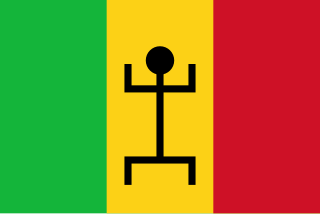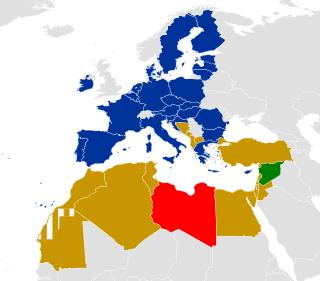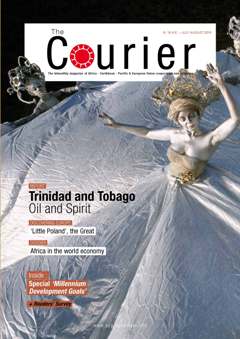
The French Union was a political entity created by the French Fourth Republic to replace the old French colonial empire system, colloquially known as the "French Empire". It was de jure the end of the "indigenous" status of French subjects in colonial areas.
The European Union has a number of relationships with foreign states. According to the European Union's official site, and a statement by Commissioner Günter Verheugen, the aim is to have a ring of countries, sharing EU's democratic ideals and joining them in further integration without necessarily becoming full member states.
European integration is the process of industrial, economic, political, legal, social, and cultural integration of states wholly or partially in Europe, or nearby. European integration has primarily but not exclusively come about through the European Union and its policies.
A European Union Association Agreement or simply Association Agreement (AA) is a treaty between the European Union (EU), its Member States and a non-EU country that creates a framework for co-operation between them. Areas frequently covered by such agreements include the development of political, trade, social, cultural and security links.
The Lomé Convention is a trade and aid agreement between the European Economic Community (EEC) and 71 African, Caribbean, and Pacific (ACP) countries, first signed in February 1975 in Lomé, Togo.

The Cotonou Agreement is a treaty between the European Union and the African, Caribbean and Pacific Group of States. It was signed in June 2000 in Cotonou, Benin's largest city, by 78 ACP countries and the then fifteen Member States of the European Union. It entered into force in 2003 and was subsequently revised in 2005 and 2010.

The Organisation of African, Caribbean and Pacific States is a group of countries in Africa, the Caribbean, and the Pacific that was created by the Georgetown Agreement in 1975. Formerly known as African, Caribbean and Pacific Group of States (ACP), the organisation's main objectives are sustainable development and poverty reduction within its member states, as well as their greater integration into the world's economy. All of the member states, except Cuba, are signatories to the Cotonou Agreement with the European Union.

The Mali Federation was a federation in West Africa linking the French colonies of Senegal and the Sudanese Republic for two months in 1960. It was founded on 4 April 1959 as a territory with self-rule within the French Community and became independent after negotiations with France on 20 June 1960. Two months later, on 19 August 1960, the Sudanese Republic leaders in the Mali Federation mobilized the army, and Senegal leaders in the federation retaliated by mobilizing the gendarmerie ; this resulted in a tense stand-off, and led to the withdrawal from the federation by Senegal the next day. The Sudanese Republic officials resisted this dissolution, cut off diplomatic relations with Senegal, and defiantly changed the name of their country to Mali. For the brief existence of the Mali Federation, the premier was Modibo Keïta, who would later become the first President of Mali, and its government was based in Dakar, the eventual capital of Senegal.

Although there has been a large degree of integration between European Union member states, foreign relations is still a largely intergovernmental matter, with the 27 states controlling their own relations to a large degree. However, with the Union holding more weight as a single entity, there are at times attempts to speak with one voice, notably on trade and energy matters. The High Representative of the Union for Foreign Affairs and Security Policy personifies this role.
The European Union-Mediterranean Free Trade Area, also called the Euro-Mediterranean Free Trade Area or Euromed FTA, is based on the Barcelona Process and European Neighbourhood Policy (ENP). The Barcelona Process, developed after the Barcelona Conference in successive annual meetings, is a set of goals designed to lead to a free trade area in the Mediterranean Region and the Middle East by 2010.

The Technical Centre for Agricultural and Rural Cooperation ACP-EU (CTA) was established in 1983 under the Lomé Convention between the African, Caribbean and Pacific Group of States and EU member states. Since 2000 CTA has operated within the framework of the ACP-EU Cotonou Agreement with a mission to “strengthen policy and institutional capacity development and information and communication management capacities of ACP agricultural and rural development organisations. It assists such organisations in formulating and implementing policies and programmes to reduce poverty, promote sustainable food security, preserve the natural resource base and thus contribute to building self-reliance in ACP rural and agricultural development.”. The centre is closed in 2020, after the end of the Cotonou Agreement and the subsequent end of its financing.
The Arusha Agreement was a treaty signed on 24 September 1969 in Arusha, Tanzania, between the European Community and the three East African states of Kenya, Uganda and Tanzania. The agreement entered into force on 1 January 1971, concomitant with the second Yaoundé Convention, with the aim of establishing better economic relations between the EC and the African states. At the end of their validity time, the Lomé Convention was signed which substituted the previous agreements and enlarged them to 46 ACP countries.
Economic Partnership Agreements (EPAs) are a scheme to create a free trade area (FTA) between the European Union and other countries. They are a response to continuing criticism that the non-reciprocal and discriminating preferential trade agreements offered by the EU are incompatible with WTO rules. The EPAs date back to the signing of the Cotonou Agreement. The EPAs with the different regions are at different states of play. The EU has signed EPAs with the following countries: the Southern African Development Community (SADC), ECOWAS, six countries in Eastern and Southern Africa, Cameroon, four Pacific states, and the CARIFORUM states. Their defining characteristic is that they open up exports to the EU immediately, while exports to the partner regions is opened up only partially and over transitioning periods.

Development cooperation between the European Union (EU) and the countries of the African, Caribbean and Pacific Group of States (ACP) started in 1957 with the Treaty of Rome, which first established a collective European development policy. The Treaty of Rome granted associated status to 31 overseas collectivities and territories (OCTs) and provided for the creation of a European Development Fund (EDF) intended to grant technical and financial assistance to the countries which were still under European rule at the time. More significantly, however, by means of the Treaty of Rome the six member states of the European Economic Community were expressing solidarity with the colonies and OCTs and committed themselves to contribute to their prosperity. The EDF has to date been funded outside the EU budget by the EU Member States on the basis of financial payments related to specific contribution shares, or “keys”, which are subject to negotiation. The EDF is currently the only EU policy instrument that is financed through a specific key that is different from the EU budget key, and which reflects the comparative interests of individual Member States.
The EUR.1 movement certificate is a form used in international commodity traffic. The EUR.1 is most importantly recognized as a certificate of origin in the external trade in legal sense, especially within the framework of several bi- and multilateral agreements of the Pan-European preference system.

The ACP–EU Joint Parliamentary Assembly was created to bring together the elected representatives of the European Union and the elected representatives of the African, Caribbean and Pacific states that have signed the Cotonou Agreement.

The Union for the Mediterranean is an intergovernmental organization of 43 member states from Europe and the Mediterranean Basin: the 27 EU member states and 16 Mediterranean partner countries from North Africa, Western Asia and Southern Europe. It was founded on 13 July 2008 at the Paris Summit for the Mediterranean, with an aim of reinforcing the Euro-Mediterranean Partnership (Euromed) that was set up in 1995 as the Barcelona Process. Its general secretariat is located in Barcelona, Catalonia, Spain.

The Courier was an ACP-EU development magazine published by the Development Directorate General of the European Commission, focusing on ACP-EU Development Cooperation. Financed by the European Development Fund (EDF), it was published every two months, till it came to end in 2011. Its last edition was nr 24 covering months of July and August 2011. Its overall stated objective is to communicate, explain, promote and support the development objectives and principles of the Cotonou Agreement.

The Eurosphere or the European Empire is a concept associated with the public intellectual Mark Leonard, Oxford University academic Jan Zielonka, the European Union Director-General for Politico-Military Affairs Robert Cooper and the former European Commission President José Manuel Barroso.

Cooperation between Papua New Guinea and the European Union is developed in the framework of Cotonou Agreement within the wider ACP–EU development cooperation. While neighboring Australia as the largest donor is the only country which provides direct budget supports, European Union is one of the major other sources of international assistance in the country. Since 2011 European Union is the second largest export market accounting for 9.2% of total exports by the country.











